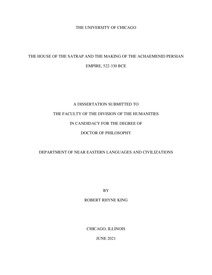At its height, the Achaemenid Persian Empire (550-330 BCE) stretched from Egypt and the Balkans to Central Asia and the Indus. How was this continental empire able to endure at such scale for over two centuries? This dissertation provides an answer to this question through the analysis of a particular institution: the house of the satrap. Satraps were the local representatives of royal power in the Achaemenid Empire who managed the interface between state and subject. Satraps operated not alone but rather through their entire “house,” as the primary source languages say. These houses included other humans such as the satrap’s family, free subordinates, and dependent laborers, as well as property such as agricultural estates. It is at the level of the satrapal house where the quotidian acts of imperialism took place. This dissertation is structured around a series of case studies which examine particular satrapal houses. Two chapters consider the careers of three contemporary satraps (Tissaphernes, Pharnabazus, and Cyrus the Younger) in western Anatolia, with the first focusing on economic history and the second on social history. The next chapter studies Aršāma, whose activities spanned Egypt and Mesopotamia, and analyzes the structures of labor within his house. The following chapter narrates the career of Bēlšunu, a local official who rose to become satrap in Syria through fastidious dealings with his imperial superiors. Another chapter considers Bakabaduš, satrap in eastern Iran, whose house facilitated the movement of people, goods, and information across the Iranian plateau. The final case study examines the career of Axvamazdā, whose house cannot be disentangled from the complex road system that stretched across Achaemenid Central Asia. A chapter that summarizes broader patterns from these case studies concludes the dissertation.






No comments:
Post a Comment